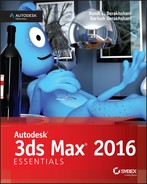Appendix
Autodesk 3ds Max Certification
Autodesk certifications are industry-recognized credentials that can help you succeed in your design career—providing benefits to both you and your employer. Getting certified is a reliable validation of skills and knowledge, and it can lead to accelerated professional development, improved productivity, and enhanced credibility.
This Autodesk Official Press guide can be an effective component of your exam preparation for the Autodesk® 3ds Max® 2016 certification exam. Autodesk highly recommends (and we agree!) that you schedule regular time to prepare, review the most current exam preparation road map available at www.autodesk.com/certification, use Autodesk Official Press books, take a class at an Authorized Training Center (find ATCs near you at www.autodesk.com/atc), take an assessment test, and use a variety of resources to prepare for your certification—including plenty of actual hands-on experience.
![]()
Table A.1 is for the Autodesk 3ds Max 2016 Certified Professional exam and lists the topics, exam objectives, and the chapter where the information for each objective is found—and in the chapters, you'll find certification icons like the one in the margin here to indicate where objectives are covered. This book will give you a foundation for the basic objectives covered in the exam, but you will need further study and hands-on practice to complete and pass the Professional exam.
These Autodesk certification exam objectives were accurate at press time. To find the latest information about the exam and what is covered, go to www.autodesk.com/certification. Good luck preparing for your certification!
Table A.1 3ds Max 2016 exam objectives
| Topic | Exam Objective | Chapter or Appendix |
| Animation | Create a path animation and evaluate an object along the path | Not Covered |
| Identify controller types | Chapters 5, 6 | |
| Identify playback settings | Chapters 5, 6 | |
| Locate the value of keys in the time slider | Chapters 5, 6 | |
| Use a Dope Sheet | Chapter 12 | |
| Cameras | Differentiate camera types | Chapter 14 |
| Edit FOV (Field of View) | Not Covered | |
| Data management/interoperability | Chapters 1, 14 | |
| Differentiate common file types and usages | Not Covered | |
| Use the import feature to import model data | Chapter 3 | |
| Effects | Use atmosphere effect | Chapter 13 |
| Identify particle systems | Not Covered | |
| Identify Space Warp types | Not Covered | |
| Lighting | Compare attenuation and decay | Chapter 13 |
| Differentiate light functions in a scene | Chapter 13 | |
| Identify parameters for modifying shadows | Chapter 13 | |
| Use the Daylight System | Chapter 15 | |
| Use the Light Lister | Chapter 15 | |
| Materials / Shading | Identify Shader parameters | Chapter 9 |
| Identify Standard materials | Chapter 9 | |
| Use the Material Editor | Chapters 9, 10, 15 | |
| Modeling | Differentiate reference coordinate systems | Chapters 1, 2, 7, 8 |
| Differentiate workflow | Chapters 2, 7, 8 | |
| Differentiate standard versus extended primitives | Not Covered | |
| Identify clone types | Chapters 2, 7, 8 | |
| Identify vertex types | Chapter 2 | |
| Use object creation and modification workflows | Chapters 2, 7, 8 | |
| Use polygon modeling tools | Chapters 2, 7 | |
| Use ProBoolean | Not Covered | |
| Rendering | Differentiate renderers | Chapter 15 |
| Identify rendering parameters | Chapter 15 | |
| Rigging | Use Character Studio for rigging | Chapter 11 |
| Create simple bipeds | Chapter 11 | |
| Use the Skin modifier | Chapter 12 | |
| UI/Object Management | Describe and use object transformations | Chapters 1, 2, 5 |
| Identify selection regions | Chapters 2, 7, 8 | |
| Use viewports | Chapters 1, 2 | |
| Set up and use scenes | Chapters 1, 2 |
